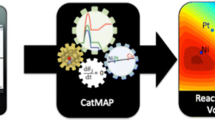Abstract
The reaction force F(ξ) is the negative gradient of the potential energy of a chemical process along the intrinsic reaction coordinate ξ. We extend the rigorous concept of F(ξ) to the “activation strain model” of Bickelhaupt et al., to formulate the “strain” force F str(ξ) that retards a reaction and the “interaction” force F int(ξ) that drives it. These are investigated for a group of Diels-Alder cycloadditions. The results fully support the interpretation of the minimum of F(ξ) as defining the beginning of the transition from deformed reactants to eventual products.






Similar content being viewed by others
References
Toro-Labbé A (1999) J Phys Chem A 103:4398–4403
Jaque P, Toro-Labbé A, Politzer P, Geerlings P (2008) Chem Phys Lett 456:135–140
Dewar MJS (1984) J Am Chem Soc 106:209–219
Yepes D, Murray JS, Politzer P, Jaque P (2012) Phys Chem Chem Phys 14:11125–11134
Politzer P, Murray JS, Jaque P (2013) J Mol Model 19:4111–4118
Toro-Labbé A, Gutiérrez-Oliva S, Concha MC, Murray JS, Politzer P (2004) J Chem Phys 121:4570–4576
Politzer P, Burda JV, Concha MC, Lane P, Murray JS (2006) J Phys Chem A 110:756–761
Toro-Labbé A, Gutiérrez-Oliva S, Murray JS, Politzer P (2007) Mol Phys 105:2619–2625
Burda JV, Toro-Labbé A, Gutiérrez-Oliva S, Murray JS, Politzer P (2009) J Phys Chem A 113:6500–6503
Politzer P, Toro-Labbé A, Gutiérrez-Oliva S, Murray JS (2012) Adv Quantum Chem 64:189–210
Yepes D, Donoso-Tauda O, Pérez P, Murray JS, Politzer P, Jaque P (2013) Phys Chem Chem Phys 15:7311–7320
Polanyi JC, Zewail AH (1995) Acc Chem Res 28:119–132
Zewail AH (2000) J Phys Chem A 104:5660–5694
Yepes D, Murray JS, Pérez P, Domingo LR, Politzer P, Jaque P (2014) Phys Chem Chem Phys 16:6726–6734. doi: 10.1039/c3cp54766c
Gutiérrez-Oliva S, Díaz, S, Toro-Labbé A, Lane P, Murray JS, Politzer P (2014) Mol Phys 112:349–354. doi: 10.1080/00268976.2013.819452
Herrera B, Toro-Labbé A (2004) J Chem Phys 121:7096–7102
Bickelhaupt FM (1999) J Comput Chem 20:114–128
van Stralen JNP, Bickelhaupt FM (2006) Organometallics 25:4260–4268
van Zeist W-J, Koers AH, Wolters LP, Bickelhaupt FM (2008) J Chem Theory Comput 4:920–928
van Zeist W-J, Bickelhaupt FM (2010) Org Biomol Chem 8:3118–3127
Frisch MJ, Trucks GW, Schlegel HB, Scuseria GE, Robb MA et al (2003) Gaussian 03. Gaussian Inc, Wallingford, CT
Domingo LR, Pérez P, Sáez JA (2012) Org Biomol Chem 10:3841–3851
Acknowledgments
The activation strain model of Bickelhaupt et al. was brought to our attention by Professor Bickelhaupt’s presentation in the Virtual Conference on Computational Chemistry (VCCC-2013) organized by Professor Ponnadurai Ramasami. We would like to express our appreciation to both of them. The authors also acknowledge Fondo Nacional de Desarrollo Científico y Tecnológico (FONDECYT) through the project N° 1100291. D.Y. thanks La Comisión Nacional de Investigación Científica y Tecnológica (CONICYT) for a PhD fellowship.
Author information
Authors and Affiliations
Corresponding author
Additional information
This paper belongs to Topical Collection MIB 2013 (Modeling Interactions in Biomolecules VI)
Rights and permissions
About this article
Cite this article
Politzer, P., Murray, J.S., Yepes, D. et al. Driving and retarding forces in a chemical reaction. J Mol Model 20, 2351 (2014). https://doi.org/10.1007/s00894-014-2351-0
Received:
Accepted:
Published:
DOI: https://doi.org/10.1007/s00894-014-2351-0




